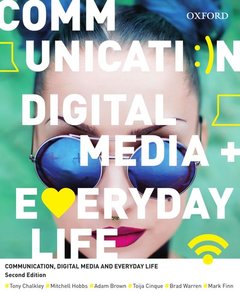Description
Communication, Digital Media and Everyday Life (2nd Ed.)
Authors: Chalkley Tony, Hobbs Mitchell, Brown Adam, Cinque Toija, Warren Dr Brad, Finn Mark
Language: English45.81 €
In Print (Delivery period: 21 days).
Add to cart
Publication date: 10-2015
384 p. · 20.5x24.9 cm · Paperback
384 p. · 20.5x24.9 cm · Paperback
Description
/li>Biography
/li>
Communication, Digital Media and Everyday Life (Second Edition) uses stories to explain the journey from 'new media in communication' to 'digital media is communication' and provide a clear introduction to communication and media theory and practice. For Generations Y and Z, digital media is now embedded into most aspects of daily life and integrated into contemporary communication as much as speaking, reading and writing. This book encourages readers to understand how they use 'new' media to do 'old' things and explores how concepts of communication, digital media and everyday life intersect with one another. The first section part of the book introduces the building blocks of communication; its basic tools, devices and approaches. The second section part takes these ideas and concepts in the first part and applies them to 'new' media: it considers including ideology in film and television; organisational communication; and values in the new digital world; and how identity, privacy, deception and truth have been redefined. The third part section part looks at communication today-including the redefinition of identity, privacy, deception and truth- and explores what it might be like to live in an increasingly digital world.
Tony Chalkley, Senior Lecturer, School of Communication and Creative Arts, Deakin University Mitchell Hobbs, Lecturer in Media and Public Relations, Department of Media and Communications, The University of Sydney Adam Brown, Senior Lecturer, School of Communication and Creative Arts, Deakin University Toija Cinque, Senior Lecturer, School of Communication and Creative Arts, Deakin University Brad Warren, Contract Lecturer and Research Consultant, School of Communication and Creative Arts, Deakin University Mark Finn, Senior Lecturer, Department of Media and Communication, Swinburne University of Technology
© 2024 LAVOISIER S.A.S.




